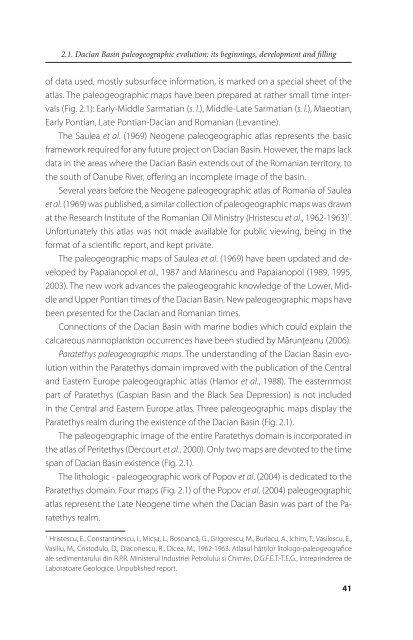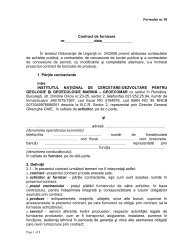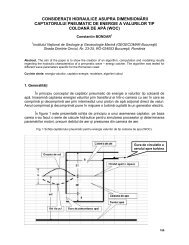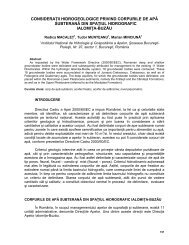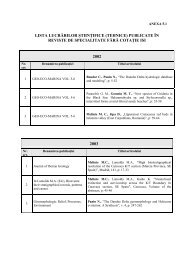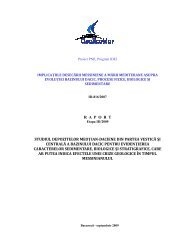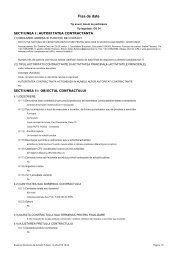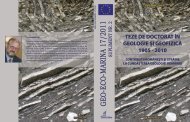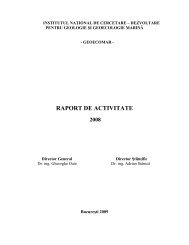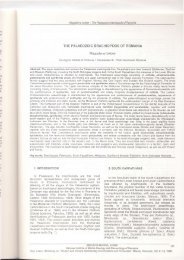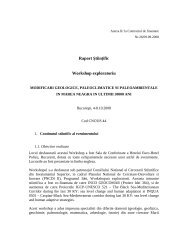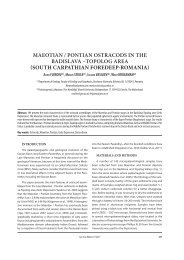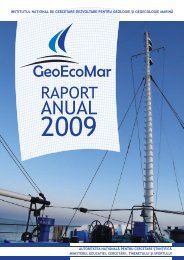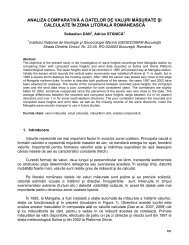DACIAN BASIN - GeoEcoMar
DACIAN BASIN - GeoEcoMar
DACIAN BASIN - GeoEcoMar
You also want an ePaper? Increase the reach of your titles
YUMPU automatically turns print PDFs into web optimized ePapers that Google loves.
2.1. Dacian Basin paleogeographic evolution: its beginnings, development and filling<br />
of data used, mostly subsurface information, is marked on a special sheet of the<br />
atlas. The paleogeographic maps have been prepared at rather small time intervals<br />
(Fig. 2.1): Early-Middle Sarmatian (s. l.), Middle-Late Sarmatian (s. l.), Maeotian,<br />
Early Pontian, Late Pontian-Dacian and Romanian (Levantine).<br />
The Saulea et al. (1969) Neogene paleogeographic atlas represents the basic<br />
framework required for any future project on Dacian Basin. However, the maps lack<br />
data in the areas where the Dacian Basin extends out of the Romanian territory, to<br />
the south of Danube River, offering an incomplete image of the basin.<br />
Several years before the Neogene paleogeographic atlas of Romania of Saulea<br />
et al. (1969) was published, a similar collection of paleogeographic maps was drawn<br />
at the Research Institute of the Romanian Oil Ministry (Hristescu et al., 1962-1963) 1 .<br />
Unfortunately this atlas was not made available for public viewing, being in the<br />
format of a scientific report, and kept private.<br />
The paleogeographic maps of Saulea et al. (1969) have been updated and developed<br />
by Papaianopol et al., 1987 and Marinescu and Papaianopol (1989, 1995,<br />
2003). The new work advances the paleogeograhic knowledge of the Lower, Middle<br />
and Upper Pontian times of the Dacian Basin. New paleogeographic maps have<br />
been presented for the Dacian and Romanian times.<br />
Connections of the Dacian Basin with marine bodies which could explain the<br />
calcareous nannoplankton occurrences have been studied by Mărunţeanu (2006).<br />
Paratethys paleogeographic maps. The understanding of the Dacian Basin evolution<br />
within the Paratethys domain improved with the publication of the Central<br />
and Eastern Europe paleogeographic atlas (Hamor et al., 1988). The easternmost<br />
part of Paratethys (Caspian Basin and the Black Sea Depression) is not included<br />
in the Central and Eastern Europe atlas. Three paleogeographic maps display the<br />
Paratethys realm during the existence of the Dacian Basin (Fig. 2.1).<br />
The paleogeographic image of the entire Paratethys domain is incorporated in<br />
the atlas of Peritethys (Dercourt et al., 2000). Only two maps are devoted to the time<br />
span of Dacian Basin existence (Fig. 2.1).<br />
The lithologic - paleogeographic work of Popov et al. (2004) is dedicated to the<br />
Paratethys domain. Four maps (Fig. 2.1) of the Popov et al. (2004) paleogeographic<br />
atlas represent the Late Neogene time when the Dacian Basin was part of the Paratethys<br />
realm.<br />
1 Hristescu, E., Constantinescu, I., Micşa, L., Bosoancă, G., Grigorescu, M., Burlacu, A., Ichim, T., Vasilescu, E.,<br />
Vasiliu, M., Cristodulo, D., Diaconescu, R., Dicea, M., 1962-1963. Atlasul hărţilor litologo-paleogeografice<br />
ale sedimentarului din R.P.R. Ministerul Industriei Petrolului si Chimiei, D.G.F.E.T.-T.E.G., Intreprinderea de<br />
Laboratoare Geologice. Unpublished report.<br />
41


